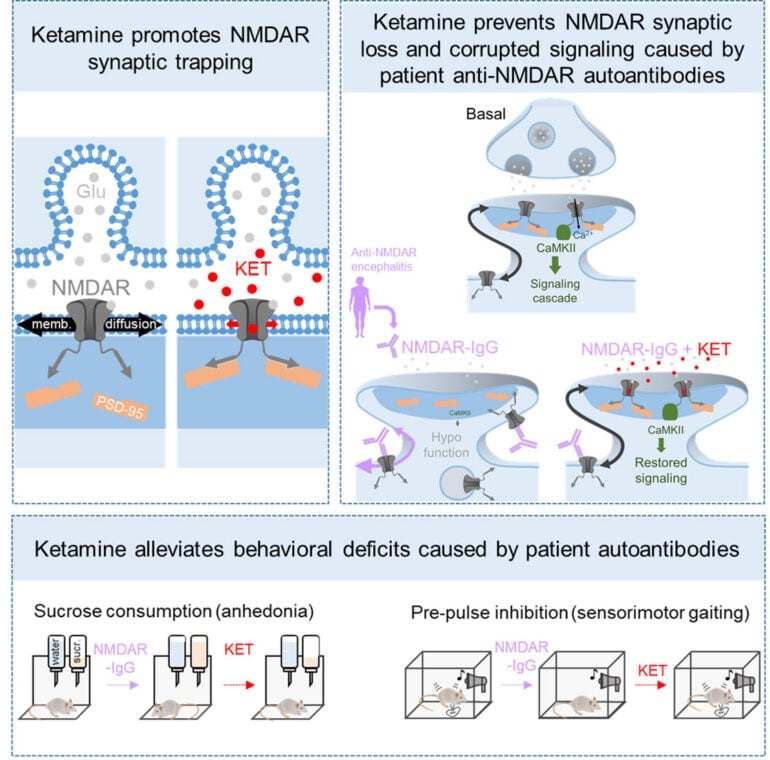
Frédéric Villéga, Alexandra Fernandes, Julie Jézéquel, Julien Dupuis, Laurent Groc, et al. in Neuron
Open channel blockers of the NMDA receptor induce behavioural responses that are not observed with competitive antagonists, suggesting that they affect different dimensions of NMDA receptor signaling. Among open channel blockers, ketamine has sparked sustained attention from physicians to neuroscientists over the past decades. Depending on the dose, ketamine exhibits powerful anesthetic or psychoactive properties, as well as an unmatched ability to rapidly alleviate the symptoms of treatment-resistant depression upon a single administration. However, the molecular mechanisms supporting these therapeutic attributes remain poorly understood. Recently, surface diffusion-based spatiotemporal rearrangements in the organization and trapping of NMDA receptor at synapses emerged as a key regulatory mechanism controlling the initiation of activity-dependent synaptic adaptations supporting cognitive functions. Indeed, while NMDA receptor-mediated calcium influxes allow the recruitment of proteins that are essential for adaptive cellular processes, an increasing corpus of studies unveils that NMDA receptor-dependent functions also involve mechanisms that do not require their ion channel features. As such, non-ionotropic signaling participates in structural plasticity, and diffusion-based surface redistributions control the amount, composition and organization of synaptic receptors and allow the recruitment of protein kinases at synapses. These discoveries prompted us to investigate whether specific subclasses of NMDA receptor antagonists may act upon NMDAR trafficking and trapping at synapses. Here, we report that ketamine and other clinically-relevant NMDA receptor open channel blockers promote interactions between NMDA receptor and PDZ domain-containing scaffolding proteins. Ketamine rapidly and efficiently enhances NMDA receptor trapping at hippocampal synapses.
In order to test the therapeutical potential of such a process, the NMDA receptor signaling was corrupted in hippocampal synapses following exposure to human autoantibodies from patients with anti-NMDAR encephalitis. Clinically, these patients suffer from cognitive deficits, major psychiatric symptoms (e.g. psychosis), seizures, abnormal movements and other clinical presentations, all of which can be ameliorated through immunotherapy. From a mechanistic point-of-view, autoantibodies do not harm NMDAR channel properties but cause their synaptic destabilization and disorganization at the plasma membrane. Remarkably, we show that ketamine-elicited trapping enhancement compensates for depletion in synaptic NMDA receptors triggered by patients’ autoantibodies. Preventing synaptic depletion mitigates impairments in NMDAR-mediated CaMKII signaling and alleviates anxiety- and sensorimotor gating-related behavioral deficits provoked by autoantibodies. Altogether, our study reveals an unexpected dimension of NMDA receptor open channel blocker, such as ketamine, and stress the potential of targeting receptor anchoring rather than activity.
Référence
Villéga F, Fernandes A, Jézéquel J, Uyttersprot F, Benac N, Zenagui S, Bastardo L, Gréa H, Bouchet D, Villetelle L, Nicole O, Rogemond V, Honnorat J, Dupuis JP, Groc L.
Ketamine alleviates NMDA receptor hypofunction through synaptic trapping.
Neuron. 2024 Jul 17:S0896-6273(24)00490-2.
doi: 10.1016/j.neuron.2024.06.028.
Groc Laboratory
Developmental Brain Physiology and Pathology
www.iins.u-bordeaux.fr/GROC
Institut Interdisciplinaire des Neurosciences, (CNRS / Université de Bordeaux UMR 5297)
Last update 24/10/24

